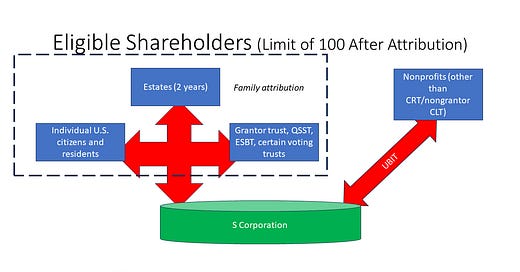C and S Corporations for Estate Planners: Eligible Shareholder Requirements
Examining some subtle, yet often-overlooked issues with share ownership
This is the seventh installment of C and S corporations for estate planners.
For the prior article in this series, click here.
For the first article in this series and a series index, click here.
Table of Contents
Intro
Another key difference between a C corporation and an S corporation are the restrictions on number, and type, of shareholders in an S corporation.
Generally, under IRC Section 1361(b)(1), an S corporation must have 100 or fewer shareholders. And, shareholders usually must be individuals – not entities. So, for example, a tax partnership or C corporation cannot be an S corporation shareholder (while a disregarded entity with an individual owner can). However, as mentioned in the last article in this series, certain trusts can be shareholders. In addition, as we will explore, an estate after the death of an individual shareholder can itself be an eligible S corporation shareholder for a period of time.
Nonprofits may also be shareholders, but this was not always the case. And, there are some interesting limitations and outcomes where tax-exempt entities and S corporations are combined.
Finally, it is important to note that individual S corporation shareholders must be U.S. citizens or residents. Nonresidents generally cannot be shareholders, other than through an electing small business trust (ESBT) to be covered below.
In the next article, we will cover high-level principles of the one-class-of-stock requirement (which can become a rabbit hole).
This article will focus primarily on trust and nonprofit ownership of S corporation stock. But, before we get started, please note that C corporations don’t have restrictions on shareholders and classes of stock. Where things get hairy for C corporations is where you have entities organized outside of the U.S., which will not be covered in this series. I leave that to the international tax experts (which, if you are one and would like to write about this for the newsletter, please reach out).
Qualifying Trusts and Estates, in General
Keep reading with a 7-day free trial
Subscribe to State of Estates to keep reading this post and get 7 days of free access to the full post archives.




